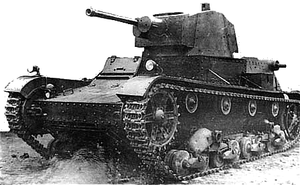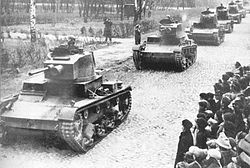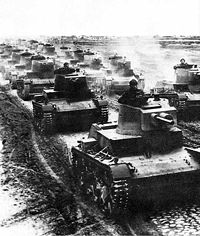| 7TP | |
|---|---|
 Single-turret 7TP | |
| Type | Light tank |
| Place of origin |
|
| Specifications | |
| Mass | 9.9 tonnes |
| Length | 4.6 m |
| Width | 2.4 m |
| Height | 2.27 m |
| Crew | 3 (commander, gunner, driver) |
|
| |
| Armor | 17 mm |
Main armament | 1×37 mm Bofors wz. 37 |
Secondary armament | 1×7.92 mm Ckm wz.30 |
| Engine |
Diesel Saurer VBLDd 110 hp (80 kW) |
| Power/weight | 11 hp/tonne |
| Suspension | leaf-spring bogie |
| Ground clearance | 381 mm |
Operational range | 150 km |
| Maximum speed | 37 km/h |
The 7TP (siedmiotonowy polski - 7-ton Polish) was the Polish light tank of the Second World War. A development of the British Vickers 6-ton, it was significantly better armed than its most common opponents, the German Panzer I and Panzer II. A standard tank of the Polish Army during the Polish Defensive War of 1939, its production never exceeded 140 vehicles. Its chassis was used as the base for C7P artillery tractor.
History[]

Twin-turreted version
Development[]
The 7TP was the Polish development of the British Vickers 6-ton (Mk.E) tank licence. The main new features of 7TP were: a better, more reliable and powerful diesel engine, 37 mm anti-tank gun and a bit thicker armour (in front, 17 mm instead of 13 mm), together with many minor modifications and additions (like the Gundlach tank periscope (pictured), different air conditioning system and a radio). Only about 132 tanks were produced between 1935 and the outbreak of the war (plus four iron prototypes). The designation 7TP meant: 7-Ton, Polish (in fact its weight increased after the initial prototype was made and the actual serial tanks weighted approximately 9 tonnes).
Like its British predecessor, the 7TP was initially produced in two variants: twin turret version armed with 2 Ckm wz.30 machine guns, and a single turret version, armed with 37 mm Bofors wz. 37 gun. After initial tests, it became clear that the twin-turret variant was obsolete and lacked firepower, so it was abandoned in favour of the more modern single turret design.

7TP was the first tank in the world with diesel engine and 360-degree Gundlach periscope.[1]
Prior to the outbreak of World War II most of the twin turret tanks were converted to single turret versions and only 24 twin-turret types remained in Polish service (as opposed to roughly 108 of the other type). It is to be noted that twin and single turret variants had no specific designations. In some modern books they are designated with abbreviations: "7TP dw." and "7TP jw." (Polish abbreviation for jednowieżowy - single turreted, and dwuwieżowy - dual turreted). However, these were not the official names of the variants and are used for simplicity's sake only.
Combat use[]
All 7TP tanks took part in combat in the Polish Defensive War of 1939. Most of them were attached to two light tank battalions (the 1st and the 2nd). The remaining tanks, that is the ones used for training as well as tanks that were finished after the outbreak of the war, were used in an improvised tank unit fighting in the defence of Warsaw. Although technically superior to any of the German light tanks of the era, the 7TP was too scarce to change the outcome of the war. The 1st Light Tank Battalion (49 single turret tanks) fought in the ranks of the Prusy Army as part of the strategic reserve force of the Polish Army. It entered combat on September 4, 1939 and fought with distinction in a variety of roles, mostly as a mobile reserve and for covering the withdrawal. It fought in a number of battles, most notably in the battles of Przedbórz, Sulejów, Inowłódz, Odrzywół and Drzewica. On September 8 it managed to stop the German advance on the centre of the Polish forces, but the following day it got separated from the main force and had to be withdrawn to the rear. Part of the battalion was destroyed in the Battle of Głowaczów, while the remainder on September 13 managed to break through to the other side of the Vistula, where it joined the Lublin Army and Col. Stefan Rowecki's Warsaw Armoured Motorised Brigade. As part of that unit, the battalion took part in the Battle of Józefów and formed part of the spearhead of the Polish units trying to break through to Lwów and the Romanian Bridgehead. After the Battle of Tomaszów Lubelski, on September 21, 1939, the remaining tanks were destroyed by their crews and the unit surrendered to the Germans.
The 2nd Light Tank Battalion (49 single turret tanks) was attached to the Piotrków Operational Group of the Łódź Army. It entered combat on September 4 near the river of Prudka, Bełchatów. The following day it was ordered to lead the Polish counter-assault on Piotrków, but the attack failed and the unit suffered heavy losses. The battalion was then rallied and withdrawn to Warsaw and then to Brześć, where it shielded the mobilization of the Polish 60th Infantry Division. On September 15 it took part in a two-days long Battle of Włodawa, but suffered heavy losses due to air bombardment and was withdrawn southwards. The remaining tanks had to be destroyed by the crews due to lack of oil and on September 17, after the Soviet Union joined Germany in her war against Poland, the crews and the staff of the unit crossed the border with Romania.


During maneuvers.
The remaining tanks found in Warsaw were formed into 1st and 2nd Company of Light Tanks by the Command of the Defence of Warsaw. The 1st company had 11 twin-turreted tanks, previously used for training. In the opening stages of the Siege of Warsaw the unit took part in heavy fights for the Warsaw's suburb of Okęcie and the major airport located there. Due to lack of anti-tank armament, the tanks of the 1st company suffered losses and were withdrawn to the rear on September 12, where the unit was joined with the 2nd company. The 2nd company had 11 single-turret tanks, as well as an unknown number of other armoured vehicles. It took part in successful defence of the borough of Wola against German infantry and armoured units. It was also used for tactical counter attacks, among others for the village of Wawrzyszew, where the company managed to disrupt enemy preparations for the assault. On September 15 the company was ordered to form a spearhead of the Polish attack aimed at linking up with the forces of the Poznań Army withdrawing after the Battle of Bzura through the Kampinos forest north of Warsaw. The attack ended up as a minor success, although the German aerial bombardment caused heavy losses both in personnel and in tanks. The remaining 7TP tanks were used on various sectors of the front until the end of the defence of Warsaw on September 27, when they were destroyed by their crews. The combat experience proved that the Bofors wz. 37 anti-tank gun used in the 7TP was able to penetrate the armour of any of the German tanks of the time, including the modern Panzer IV. On the other hand, the tank was armoured too lightly, especially against aerial bombardment. Altogether, it is estimated that 20 tanks were captured by the Germans almost intact while one was captured by the Soviets. Additional 20 were successfully withdrawn to Romania and Hungary, while almost 40 had to be abandoned due to engine problems and lack of fuel. After the fall of Poland Germans included 20 captured 7TP to 203. Panzerbataillon as Pzkpfw 731 (p). 7TP tank was used by Wehrmacht operations in 1940 in Norway and France.
Reconstruction[]
No complete 7TP tanks have survived to this day, although it is planned to build a copy of the tank for the Museum of the Polish Army in Warsaw. A 7TP is being reconstructed in Bielsko-Biała, its reconstruction will include many original parts recovered from various places in Poland. It now has an original gearbox and will be soon armed with an original 37mm Bofors gun. The tracks come from a T-26.
Operators[]
Nazi Germany - 20 7TP jw captured during German invasion of Poland.
 Poland - 133 7TP jw and 16 7TP dw.
Poland - 133 7TP jw and 16 7TP dw.Soviet Union - 1 7TP jw captured during Soviet invasion of Poland
See also[]
- Gundlach tank periscope
- T-26, a similar Soviet tank
- Comparison of early World War II tanks
External links[]
- Reconstructed 7TP gallery
- Polish Armour
- 7TP at Achtungpanzer.com
- Picture gallery at 1939.pl
- Turret cross-view
- video of reconstructed 7TP on youtube
Bibliography[]
- (English)The Encyclopedia of Tanks and Armored Fighting Vehicles - The Comprehensive Guide to Over 900 Armored Fighting Vehicles From 1915 to the Present Day, General Editor: Christopher F. Foss, 2002
- (English)Tanks of the World, 1915-1945, Peter Chamberlain, Chris Ellis, 1972
- (Polish)J. Magnuski, "Czołg lekki 7TP" vol.I, Militaria, 1996;
- (Polish) (English) Janusz Magnuski, "7TP vol.II", Militaria (317), Warsaw 2009.
- (Polish)L. Komuda, "Polski czołg lekki 7TP", TBiU nr 21, 1973;
- (Polish)A. Jońca, R. Szubański, J. Tarczyński, "Pojazdy Wojska Polskiego 1939", WKŁ, 1990;
- (Polish)J. Magnuski, "Produkcja czołgów 7TP 1935-39 r.", nTW 12/1996;
- (Polish)J. Magnuski, "Angielski lekki czołg Vickers Mark E w polskiej służbie", nTW 5/1999;
- (Polish)R. Szubański, "Polska broń pancerna 1939", wydawnictwo MON, 1982;
References[]
- ↑ 7TP vol.II,Janusz Magnuski, Militaria 317,Warszawa 2009.
| ||||||||||||||||||||
The original article can be found at 7TP and the edit history here.